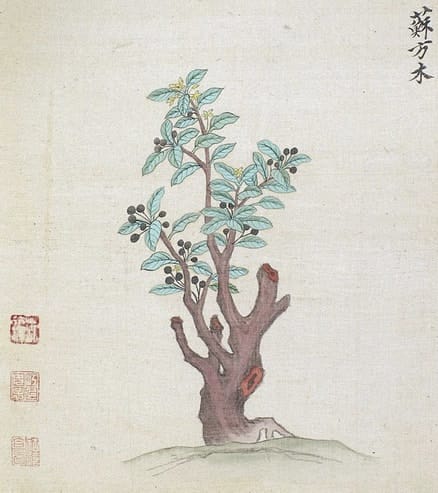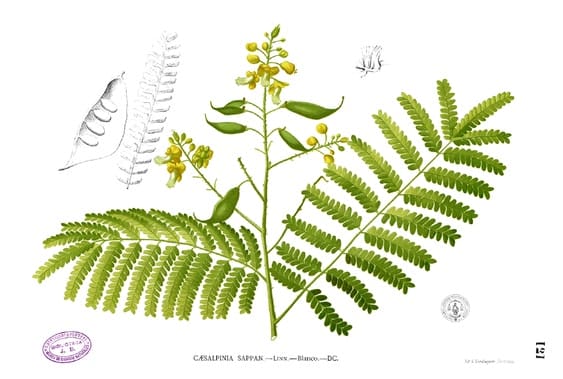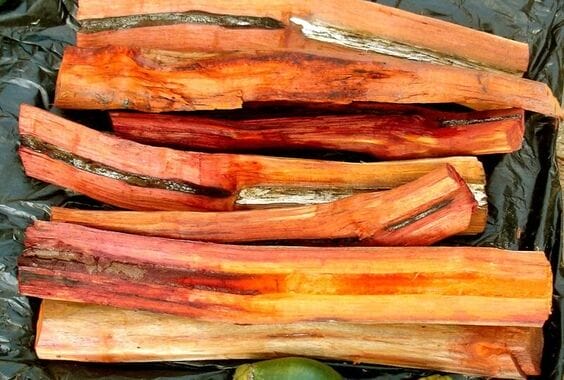Caesalpinia sappan, Pattanga, Su Mu 苏木Sappan WoodPattanga (Ayurveda) Bakam (Unani) Bukam (Arabic) Patangam (Siddha) Su Mu (TCM) |

|
 Caesalpinia sappan
Caesalpinia sappanBen Cao Tu Pu, 1644 (Welcome)
 Caesalpinia sappan
Caesalpinia sappanM. Blanco, Flora de Filipinas. (1875)
 Fresh sappanwood for sale at the Ereke market, northern Buton Island, Indonesia
Fresh sappanwood for sale at the Ereke market, northern Buton Island, Indonesia(Photo by David E Mead, cropped) (Wikimedia)
Botanical name:
Caesalpinia sappan
Parts used:
Heart wood
Temperature & Taste:
Neutral/slightly Cool. Sweet, Salty, Pungent
Classification:
K. Move the Blood
Uses:
1. Moves the Blood, Clears Stasis, Eases Pain:
-strongly moves the blood, resolves Blood stasis, alleviates swelling and pain
-Amenorrhea, Dysmenorrhea
-Uterine Fibroids, Polycystic Ovary (PCOS)
-Postpartum Pain
-stabbing or fixed pain in the Chest, Abdominal or Lower Abdominal
-Fibroid Tumors, Cancer (auxiliary)
-pain following Trauma; Sprains, Bruising, Fractures, Hematoma
2. Stops Bleeding and Leakage:
-Postpartum Bleeding (TCM)
-excessive Menstruation (Ayurveda)
-Bleeding from the Lungs or Bowels
-Diarrhea, Dysentery (Ayurveda)
3. Clears Heat from the Blood:
-Burning Syndrome (Ayurveda)
-swollen sores
Dose:
Must not be boiled in Iron pots.
As in the western tradition, to move the Blood some TCM authors recommended decocting in wine.
3–10 grams (API)
Substitutes:
1. Red Sandalwood
2. Pterocarpus marsupium
3. Sappan wood was used as a substitute for Logwood, Haematoxylon campechianum; Logwood can be used for Sappan wood.
4. Sappan wood was also used a substitute for Brazil wood, C. braziliensis. (King’s)
Main Combinations:
1. Chest or Abdominal Pain:
i. Caesalpinia sappan with Sandalwood, Safflower
ii. lower abdominal pain, Caesalpinia sappan with Zedoary
2. Dysmenorrhea, Caesalpinia sappan with Cyperus rotundus, Paeonia Bai Shao
3. Heavy postpartum bleeding with dizziness, shortness of Breath, Caesalpinia sappan with Codonopsis Dang Shen, Ophiopogon Mai Men Dong
4. Trauma with pain and bruising:
i. Caesalpinia sappan with Myrrh, Frankincense and Dragon’s Blood (TCM)
ii. Caesalpinia sappan with Myrrh, Frankincense, Dragon’s Blood, Dang Gui, Paeonia Bai Shao, Peudoginseng San Qi, Peach kernel (Tao Ren), Dipsacus Xu Duan, Saposhnikovia Fang Feng, Turmeric (Jiang Huang) (as in Jin Gu Die Shang Wan [Sinew & Bone Fall & Injury Pills] of TCM)
iii. Caesalpinia sappan with Ardisia Zi Jin Niu, Safflower
5. Chronic Gastritis, Caesalpinia sappan with China root, Dandelion, White Peony (Bai Shao), Cyperus rotundus, Licorice (TCM)
Major Formulas:
Cautions:
1. Not used during Pregnancy (TCM)
2. According to TCM sources, it is contraindicated for heavy menstrual bleeding. However, Ayurvedic sources list it for Menorrhagia. This is possibly related to the etiology of the heavy bleeding, and the medicines it is combined with.
Main Preparations used:
-
Extra Info
-
History
|
‘Sappanwood, in Sanskrit Pattanga and in Arabic and Persian Bakam, is by some Sanskrit authors included among the different kinds of Sandalwood in the same manner as the wood of Pterocarpus Santalinus. (Vide P. Santalinus.) It is cultivated in the Madras Presidency. When a daughter is born in a Thean family, the father plants a certain number of Sappan trees which form her dowry when married. Sappan wood is not generally used as a medicine either by Hindus or Mahometans, although it is described in their books as being of use to heal wounds and stop hiemorrhage from the lungs. Ainslie, however, says that the Vytians consider a decoction of the wood as a powerful emmenagogue, and remarks that the Cochin-Chinese hold the same opinion. |
In the Bengal Dispensatory, and more recently in the Pharma-copoeia of India, it is recommended as a substitute for Logwood. At the Bombay Government Medical Depot it has been used instead of Logwood for some years. Patang is used as a dye, and a very large quantity is consumed in the preparation of Gulal, the red powder which the Hindus cover themselves with at the time of the Holi festival. This powder is made by exhausting the wood with water, the liquid extract is then poured upon Tavakir (arrowroot of Curcuma angustifolia) and well mixed by treading it with the feet, alum is then added, and the mixture dried and powdered. Some makers also add a little carbonate of soda. Cheap aniline reds are however often now used instead.’ (Pharmacographia Indica, Dymock, 1890) |
